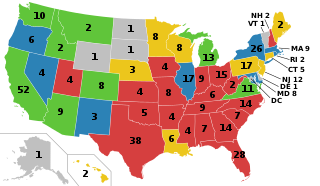Hunt v. Cromartie, 526 U.S. 541 (1999), was a United States Supreme Court case regarding North Carolina's 12th congressional district. In an earlier case, Shaw v. Reno, 509 U.S. 630 (1993), the Supreme Court ruled that the 12th district of North Carolina as drawn was unconstitutional because it was created for the purpose of placing African Americans in one district, thereby constituting illegal racial gerrymandering. The Court ordered the state of North Carolina to redraw the boundaries of the district.
Easley v. Cromartie, 532 U.S. 234 (2001), is an appeal of the United States Supreme Court case Hunt v Cromartie. The case defendant is Mike Easley, who became North Carolina governor following Jim Hunt. The court's ruling on April 18, 2001, stated that redistricting for political reasons did not violate Federal Civil Rights Law banning race-based gerrymandering..
Baker v. Carr, 369 U.S. 186 (1962), was a landmark United States Supreme Court case in which the Court held that redistricting qualifies as a justiciable question under the equal protection clause of the Fourteenth Amendment, thus enabling federal courts to hear Fourteenth Amendment-based redistricting cases. The court summarized its Baker holding in a later decision as follows: "the Equal Protection Clause of the Fourteenth Amendment limits the authority of a State Legislature in designing the geographical districts from which representatives are chosen either for the State Legislature or for the Federal House of Representatives.". The court had previously held in Gomillion v. Lightfoot that districting claims over racial discrimination could be brought under the Fifteenth Amendment.
Miller v. Johnson, 515 U.S. 900 (1995), was a United States Supreme Court case concerning "affirmative gerrymandering/racial gerrymandering", where racial minority-majority electoral districts are created during redistricting to increase minority Congressional representation.
In U.S. constitutional law, when a law infringes upon a fundamental constitutional right, the court may apply the strict scrutiny standard. Strict scrutiny holds the challenged law as presumptively invalid unless the government can demonstrate that the law or regulation is necessary to achieve a "compelling state interest". The government must also demonstrate that the law is "narrowly tailored" to achieve that compelling purpose, and that it uses the "least restrictive means" to achieve that purpose. Failure to meet this standard will result in striking the law as unconstitutional.

North Carolina is currently divided into 14 congressional districts, each represented by a member of the United States House of Representatives. After the 2000 census, the number of North Carolina's seats was increased from 12 to 13 due to the state's increase in population. In the 2022 elections, per the 2020 United States census, North Carolina gained one new congressional seat for a total of 14.
Gomillion v. Lightfoot, 364 U.S. 339 (1960), was a landmark decision of the Supreme Court of the United States that found an electoral district with boundaries created to disenfranchise African Americans violated the Fifteenth Amendment.

Shaw v. Reno, 509 U.S. 630 (1993), was a landmark United States Supreme Court case in the area of redistricting and racial gerrymandering. After the 1990 census, North Carolina qualified to have a 12th district and drew it in a distinct snake-like manner in order to create a "majority-minority" Black district. From there, Ruth O. Shaw sued to challenge this proposed plan with the argument that this 12th district was unconstitutional and violated the Fourteenth Amendment under the clause of equal protection. In contrast, Reno, the Attorney General, argued that the district would allow for minority groups to have a voice in elections. In the decision, the court ruled in a 5–4 majority that redistricting based on race must be held to a standard of strict scrutiny under the equal protection clause and on the basis that it violated the Fourteenth Amendment because it was drawn solely based on race.

League of United Latin American Citizens v. Perry, 548 U.S. 399 (2006), is a Supreme Court of the United States case in which the Court ruled that only District 23 of the 2003 Texas redistricting violated the Voting Rights Act. The Court refused to throw out the entire plan, ruling that the plaintiffs failed to state a sufficient claim of partisan gerrymandering.
Vieth v. Jubelirer, 541 U.S. 267 (2004), was a United States Supreme Court ruling that was significant in the area of partisan redistricting and political gerrymandering. The court, in a plurality opinion by Justice Antonin Scalia and joined by Chief Justice William Rehnquist and Justices Sandra Day O'Connor and Clarence Thomas, with Justice Anthony Kennedy concurring in the judgment, upheld the ruling of the District Court in favor of the appellees that the alleged political gerrymandering was not unconstitutional. Subsequent to the ruling, partisan bias in redistricting increased dramatically in the 2010 redistricting round.
Davis v. Bandemer, 478 U.S. 109 (1986), is a case in which the United States Supreme Court held that claims of partisan gerrymandering were justiciable, but failed to agree on a clear standard for the judicial review of the class of claims of a political nature to which such cases belong. The decision was later limited with respect to many of the elements directly involving issues of redistricting and political gerrymandering, but was somewhat broadened with respect to less significant ancillary procedural issues. Democrats had won 51.9% of the votes, but only 43/100 seats. Democrats sued on basis of one man, one vote, however, California Democrats supported the Indiana GOP's plan.
Wygant v. Jackson Board of Education, 476 U.S. 267 (1986), was a case before the United States Supreme Court. It is the seminal case for the "strong-basis-in-evidence standard" for affirmative action programs.
Bush v. Vera, 517 U.S. 952 (1996), is a United States Supreme Court case concerning racial gerrymandering, where racial minority majority-electoral districts were created during Texas' 1990 redistricting to increase minority Congressional representation. The Supreme Court, in a plurality opinion, held that race was the predominant factor in the creation of the districts and that under a strict scrutiny standard the three districts were not narrowly tailored to further a compelling governmental interest.
Thornburg v. Gingles, 478 U.S. 30 (1986), was a United States Supreme Court case in which a unanimous Court found that "the legacy of official discrimination ... acted in concert with the multimember districting scheme to impair the ability of "cohesive groups of black voters to participate equally in the political process and to elect candidates of their choice." The ruling resulted in the invalidation of districts in the North Carolina General Assembly and led to more single-member districts in state legislatures.
Karcher v. Daggett, 462 U.S. 725 (1983), was a United States Supreme Court case involving the legality of redistricting, and possibly gerrymandering, in the state of New Jersey.

Gerrymandering is the practice of setting boundaries of electoral districts to favor specific political interests within legislative bodies, often resulting in districts with convoluted, winding boundaries rather than compact areas. The term "gerrymandering" was coined after a review of Massachusetts's redistricting maps of 1812 set by Governor Elbridge Gerry noted that one of the districts looked like a mythical salamander.
Alabama Legislative Black Caucus v. Alabama, 575 U.S. 254 (2015), was a U.S. Supreme Court decision that overturned a previous decision by a federal district court upholding Alabama's 2012 redrawing of its electoral districts. The Alabama legislature had focused on reducing the difference in population between the districts to 1% or less, while keeping the same proportion of minority voters in each district. The Alabama Legislative Black Caucus and Alabama Democratic Conference challenged this on the grounds that it was an illegal racial gerrymander, banned under the Equal Protection Clause of the Fourteenth Amendment.
Bethune-Hill v. Virginia State Bd. of Elections, 580 U.S. ___ (2017), was a case in which the United States Supreme Court evaluated whether Virginia's legislature – the Virginia General Assembly – violated the Equal Protection Clause of the Fourteenth Amendment to the United States Constitution by considering racial demographics when drawing the boundaries of twelve of the state's legislative districts.

Redistricting in North Carolina has been a controversial topic due to allegations and admissions of gerrymandering.
Virginia House of Delegates v. Bethune-Hill, 587 U.S. ___ (2019), was a case argued before the United States Supreme Court on March 18, 2019, in which the Virginia House of Delegates appealed against the decision in 2018 by the district court that 11 of Virginia's voting districts were racially gerrymandered, and thus unconstitutional. The Court held the "Virginia House of Delegates lacks standing to file this appeal, either representing the state's interests or in its own right." In other words, the court upheld the decision made by a federal district court ruling in June 2018 that 11 state legislative districts were an illegal racial gerrymander. This was following a previous (2017) case, Bethune-Hill v. Virginia State Bd. of Elections.





